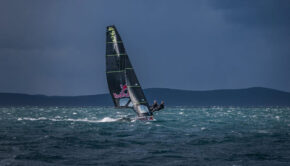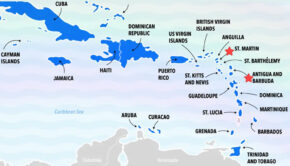IDEC SPORT Gybe day for Jules Verne Attempt
Published on November 23rd, 2015
(November 23, 2015; Day 2) – Francis Joyon (FRA), is skippering the 31.5m VPLP-designed trimaran IDEC SPORT, on his assault of the coveted Jules Verne Trophy. At 1300hrs on Monday 23rd November, IDEC SPORT was heading due south at between 25 and 30 knots on the port tack, 650 miles west of the Straits of Gibraltar. Francis Joyon’s men had already sailed 900 miles since setting off from Ushant, 36 hours earlier. IDEC SPORT gybed towards the south off Gibraltar, a few minutes later, the trimaran picked up speed under the big gennaker.
The distance sideways in comparison to the winning route adopted by Loïck Peyron and his men in 2012 (they sailed very close to the coast of Morocco) is now almost 400 miles. It is only when their routes come together again that the distance to the finish will have any real meaning, as Banque Populaire had to carry out a lot of gybes to get to the South Atlantic.
That won’t be the case for IDEC SPORT, who is in with a chance of doing it with just one gybe. So we will have to wait and see to draw up any comparisons. In terms of the numbers, they look unfavourable for IDEC (77 miles behind). With the gybe, IDEC SPORT has got back to a good VMG – Velocity Made Good.
Francis Joyon was able to answer some questions for the first time since the start off Ushant. Remaining incredibly calm as ever, he talked about the “spectacular” conditions during the first 24 hours of racing, the aim of the gybe and how united the six crewmen have been aboard the big, red trimaran.
Francis, you’ve just gybed, can you explain the situation to us?
“Yes, we have moved to the port tack and hoisted the gennaker. The aim is to follow a route that will take us down to the Equator. The northerly air flow associated with the area of low pressure meant that we were heading further and further west, so the time came when we needed to follow a more direct route. At the moment we have a bearing of 180°, due south, heading straight for the Equator.”
Does that mean that IDEC SPORT could cross the Equator after just one gybe?
“One route indicated we will have to come back on the other tack late this afternoon, while another suggests we can continue all the way there. Our bearing has improved, so we’re hoping to continue straight ahead… and even if we have to gybe back to get lined up again, it’s not a serious problem.”
Are you still hoping to cross the Equator in more or less five days?
“That is what we are hoping for. Yesterday we found it hard to go as fast as we would have liked, s the seas were very rough particularly off Cape Finisterre. The boat was bouncing around on the swell downwind… it was quite spectacular. But now that the sea has calmed somewhat in the past few hours, we should be able to reach our target speeds more easily.”
Can you tell us about the first 24 hours of this attempt?
“It was quite hairy. The boat was going crazy. The seas weren’t in the same direction as the wind, which complicates matters no end. The boat was really slamming at times… We made our way out of it without too much damage. We just have two or three little things to take care of, such as the protection for the helmsman, but there’s nothing serious. We have been quite lucky over the first 24 hours of racing, looking at the way the boat moves and the distance we have covered.”
We get the impression you are quite pleased about this first part…
“Yes. I don’t think I’ve ever had such a quick crossing of the Bay of Biscay. In spite of the waves and gusts, we haven’t been held up. We managed to keep up high average speeds and the fact that we’re now on the direct route south is pleasing too. It’s great!”
What’s the atmosphere like with your crewmen?
“It’s only natural that we’re a bit tired, as the pace has been hectic since the start. We haven’t had much sleep or had time to rest and haven’t eaten much. So, we’re pleased now to be able to eat without seeing the food go overboard or fall on the floor. We had to remain cautious in the squalls and we were extremely busy with the boat. Apart from that, we’re all helping each other out all the time. We have set up a watch system with frequent changes and that is working well. Everyone’s pulling together to get the boat sailing well. We’re going to accelerate”
As you make your way south, you won’t be as cold on board…
“That’s true. It was very cold on the first night and off Cape Finisterre. But now the temperature has climbed back up. Outside at daybreak, we could see some huge black clouds with squalls, but now the sun is breaking through and the skies are gradually clearing. It’s not impossible that we might get some bright weather later today, so that is going to be nice…”
Has the sea state improved?
“The pattern with a cross sea state making the boat’s passage very violent has eased. It’s much smoother now and so is very pleasant. Gwénolé (Gahinet) replaced me at the helm and the wind is picking up as I speak to you. I think we should be accelerating very soon.”
The Jules Verne Trophy is a prize for the fastest circumnavigation of the world by any type of yacht with no restrictions on the size of the crew, starting and finishing between the Le Créac’h Lighthouse off the tip of Brittany and the Lizard Point in Cornwall.
The 6-man team must return by 15:44:15 UTC on January 6, 2016 to beat the current records. The current record held by Loïck Peyron and his crew on Banque Populaire V is 45 days, 13 hours, 42 minutes and 53 seconds.
The crew of IDEC SPORT:
Francis Joyon (FRA)
Bernard Stamm (SUI)
Gwénolé Gahinet (FRA)
Alex Pella (ESP)
Clément Surtel (FRA)
Boris Herrmann (GER)
IDEC SPORT: http://www.idecsport-sailing.com/?lang=en









 We’ll keep your information safe.
We’ll keep your information safe.